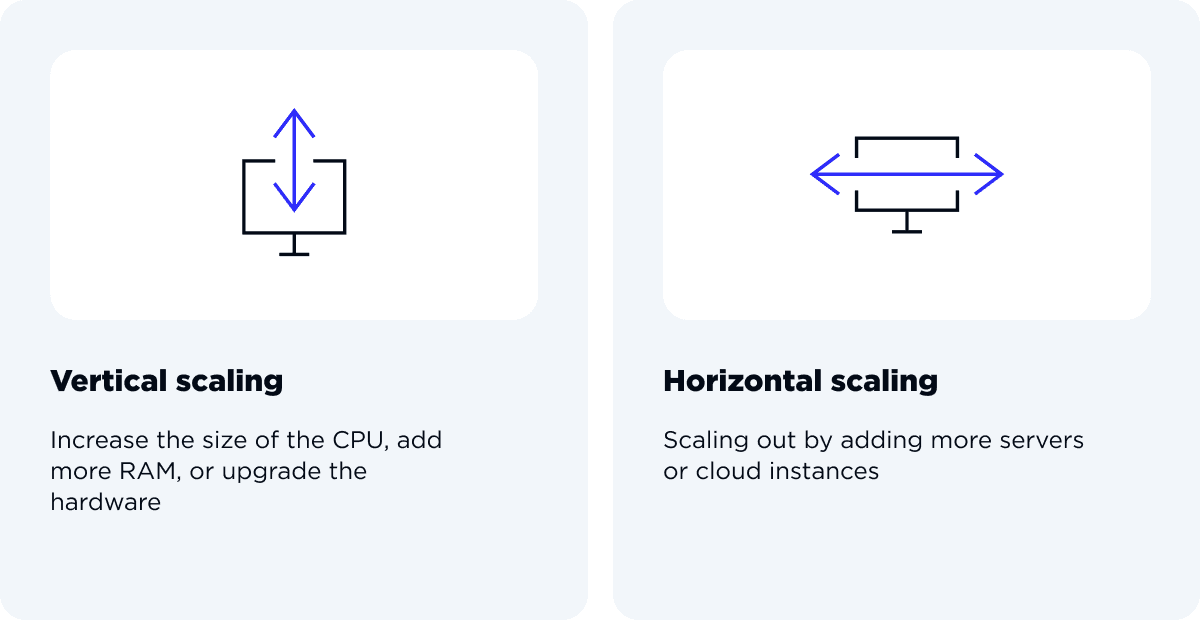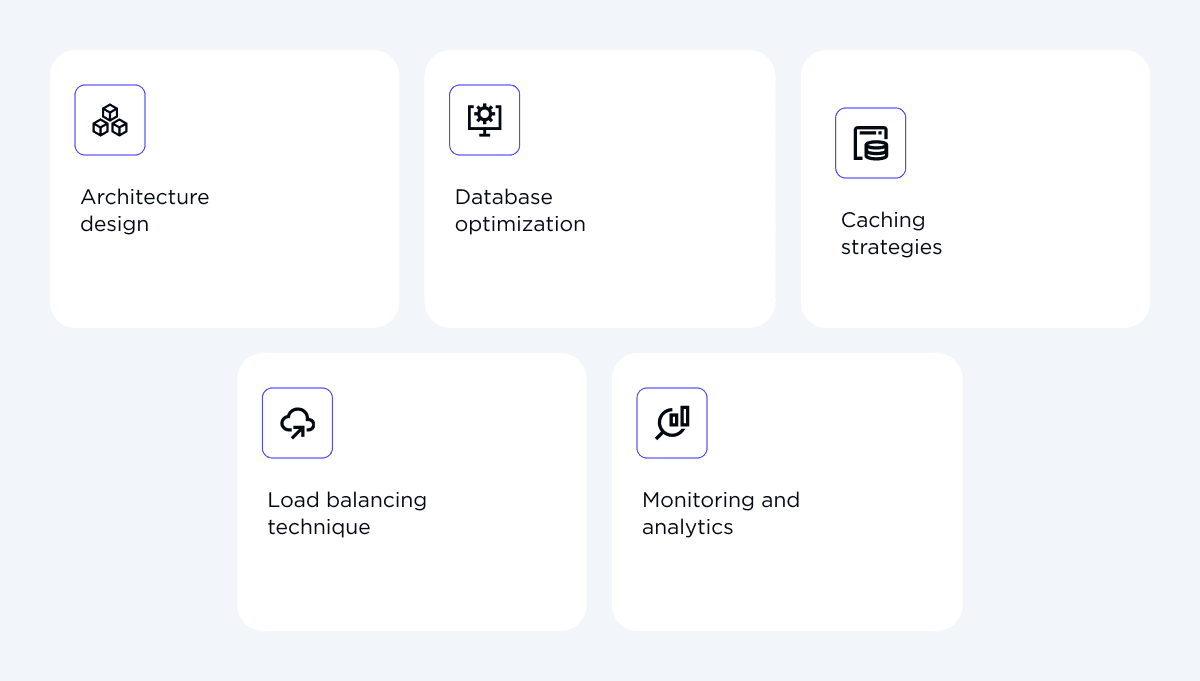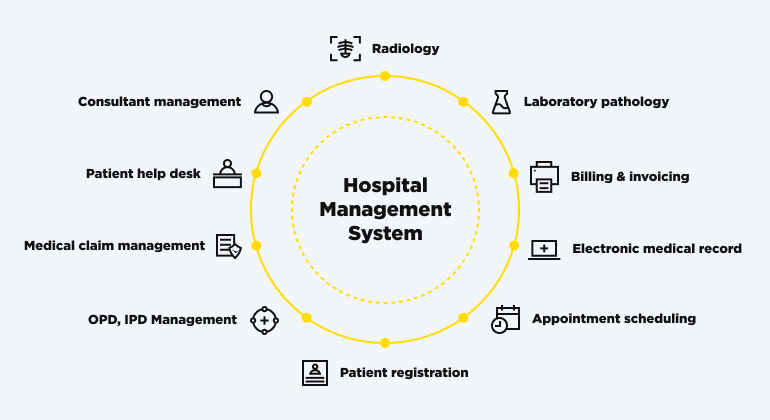The question to all product owners is – how do you define long-term goals for your business? When developing a product, there are many business objectives in front of you. One of the most important ones is scalability. There are various techniques for planning, architecture building, and testing to keep your product performing well over time. And there is no exaggeration on how crucial scalability is. According to a study by McKinsey, a lack of scalable software solutions may eventually cost businesses between 8% and 28% in revenue losses. Looks like serious data to implement software scalability. So, buckle up, and let’s find out the importance, benefits, and types of scalability you can adopt for your organization.

How Do You Define Software Scalability?
What is scalability? We would call it a new buzz in software development. Some tech specialists say it's that magic word thrown around in the meetings. All jokes aside. But what does it really mean?
Let us put it simply. Software scalability is about the ability of a system or a project to handle increased loads without compromising performance or efficiency. When you launch an application or website, you might have 1000 users, for example. However, with time, this number can grow to even 1 million users. It sounds super great for your business model growth. But your software must be prepared for this increase. And that’s what scalability is about – it ensures everything runs smoothly without crashing or slowing down.
The digital world is growing rapidly, and the scalability of software is no longer a nice-to-have feature. It is your warranty that your product can adapt to growing user demands, and keep up with the ever-changing tech landscape. If you are ready to dive deeper, let’s explore how scalability impacts your business operations and why it’s crucial for long-term success.
How Does Scalability Influence Your Business?
We have already covered it partly. But let’s imagine that your business is booming, new customers are soaring, and everything seems perfect. Of course, perfect! It’s everything you’ve dreamt about! But wait. Does your app start lagging or crashing? It won’t do that if software scalability comes into play. In other words, when your software has been properly scaled prior to your business growth, you can easily maintain your user growth and customer satisfaction, and avoid any scary downtimes.
However, it is important to note that scalability impacts not only your tech infrastructure. First of all, it’s about your business reputation. There’s no denying that you nurture your business image, and you definitely understand that customers expect seamless user experiences. Thus, a scalable solution helps you deliver just that. More importantly, the scalability of your software goes hand-in-hand with your long-term goals. As a result, it significantly drives your revenue and ROI, helps you stay ahead of the competition, and generates more and more satisfied leads.
Discovering the Benefits of Software Scalability
If you’re wondering what other benefits software development scalability brings, we are about to find that out.
Cost efficiency
One of the standout benefits of scalable software is cost efficiency. Scalable software allows you to adjust resources dynamically rather than investing in expensive hardware or overhauling systems whenever demand spikes. Pay for what you use, scale up during peak times, and scale down when things are quieter. It’s like having a flexible budget that adapts to your business needs.
Improved availability
Downtime? No, thank you! Scalable software ensures your application remains available and reliable, even during high user traffic periods. This improved availability keeps your user base happy and engaged, reducing the risk of losing customers due to frustrating outages or slow load times. It’s all about delivering consistent performance, no matter the demand.
Future-proofing
The tech world is unstoppable. It grows fast, and companies need to work hard to stay ahead. But first of all, they have to think ahead. Scalable software is your ticket to future-proofing your business. As the user base demands development and technology advances, scalable solutions allow you to adapt without starting from scratch. Whether it's integrating new features or handling increased data loads, scalability in software keeps you ready for whatever the future holds.
What are the Types, and How To Choose the Right Type of Software Scalability?
When it comes to software scalability, one size doesn’t fit all. There are different approaches to scaling. How do you choose the right one? Well, we must say that it depends on your specific needs.

Vertical scalability
Vertical scalability, or scaling up, involves enhancing the capacity of your existing hardware or software by adding more power. Think of it like upgrading your computer’s RAM or processor to handle more tasks. This approach to scalability is straightforward and can provide immediate software performance boosts. However, it does have limitations as there’s only so much you can upgrade before hitting a ceiling. In vertical scaling, the central processing unit (CPU) is the center of everything. It is aimed at handling increased workload and processing power demands. Even though there are limitations in vertical scaling, efficient CPU usage can prevent any performance bottlenecks.
Horizontal scalability
Horizontal scaling involves adding more machines or instances to your infrastructure. Instead of beefing up one server, you distribute the load across multiple servers. This approach is ideal for businesses expecting exponential growth. When engineers conduct scaling systems horizontally, asynchronous processing plays a key role. It allows tasks to be handled independently (but at the same time). It boosts responsiveness even under heavy load. It offers flexibility and reliability, ensuring your system can manage increasing demands with ease.
Of course, there are other types of scalability options. Another popular approach is implementing proprietary systems. They are custom-built and maintained by internal teams or third-party vendors. Their main benefit is that they can be highly specialized to meet specific business needs. Nevertheless, the obstacle is crucial – proprietary systems require significant investments in resources and infrastructure. That is why companies usually opt for scalable alternatives like cloud-based software systems or service-oriented architecture (SOA). We're going to discover more about it in the next section.
The Main Factors That Define Successful Scalable Solution
You should remember that creating a scalable solution is more than just involving additional resources. You need to conduct careful planning and consider several key factors. What are the factors? That’s what we’re about to discover!

Architecture design
Your software’s architecture is the backbone of scalability. Well-designed architecture patterns can make or break your ability to scale. Consider microservices architecture, for example (instead of monolithic architecture). This architectural style breaks down applications into smaller and independent services. Significantly, they can be developed, deployed, and scaled separately. Scalable architectures are all about building a robust foundation that supports growth and flexibility. Another option is serverless architecture, as cloud migration has been gaining traction. Moreover, some businesses implement hybrid ones, involving both types. Another effective architectural style is service-oriented architecture (SOA). Simply put, it structures an application as a collection of loosely coupled services.
Database optimization
Databases are the heart of many applications, and optimizing them is crucial for scalability in software development. Techniques like indexing, database sharding, and database replication can significantly enhance database performance. By ensuring your database queries are handled well, even with increased loads efficiently, you’re setting your software up for scalable success.
Caching strategies
Caching is your best friend when it comes to reducing server load and improving response times. Once you start storing frequently accessed data in a cache, you can serve simultaneous users faster and reduce the strain on your backend systems. Implementing effective caching strategies is a game-changer for scalability in software development.
Load balancing technique
Load balancing distributes incoming traffic across multiple servers to ensure no single server is overwhelmed. This not only improves optimal performance but also enhances reliability and availability. Effective distribution of load across multiple servers or database instances ensures that no single node becomes overwhelmed. What are the results? Your system is reliable and scalable even under growing demands.
Monitoring and analytics
You can’t improve what you don’t measure. Monitoring and analytics provide valuable insights into your system’s performance and help identify potential bottlenecks before they become major scalability issues. Tools like real-time monitoring, alerting, and analytics dashboards are essential for maintaining scalable systems.
What Are the Ways to Measure the Scalability of Software?
Measuring scalability in software isn’t a one-time task. Keep in mind that it’s an ongoing process. Here’s how to do it effectively.
Defining performance metrics
Start by defining the key performance metrics that matter to your business. These could include response times, throughput, error rates, and user satisfaction. Clear metrics provide a baseline for assessing how well your software scales.
Conducting baseline measurements
Before making any changes, it’s important to understand your system’s current performance. Conduct baseline measurements to capture the state of your software under normal conditions. This serves as a reference point for future scalability assessments.
Performing stress testing and scaling
Stress testing involves simulating high-traffic scenarios to see how your system performs under pressure. By pushing your software to its limits, you can identify performance issues, weaknesses, and areas for improvement. Combine stress testing with scaling experiments to find the optimal configuration for your needs.

Get in touch to discuss how our CTO as a Service can drive your success
GET STARTEDDo You Face Any Challenges in the Scaling Process?
We can’t help mentioning that there are also common scalability challenges that may be difficult to avoid. However, you can always handle them! Let’s explore some common obstacles businesses face during the scaling journey.
Issues related to resource management
Managing resource usage effectively is crucial for scalability in software development. Insufficient resources can lead to performance degradation while over-provisioning can be costly. Striking the right balance and maintaining efficient resource utilization is key to ensuring your system scales efficiently.
Common performance bottlenecks
Performance bottlenecks occur when a part of your system can’t handle increased loads, causing slowdowns or failures. Identifying and addressing these bottlenecks is essential for maintaining performance during scaling. It is also important to optimize processing logic. This way, all the core tasks are distributed efficiently, which leads to better performance even under pressure.
Ability to maintain data consistency
As you conduct scalability of software, ensuring data consistency becomes more challenging. Distributed systems, in particular, require careful management to avoid data conflicts and ensure accurate, reliable information across all nodes.
Coping with increased complexity
Scaling often brings increased complexity, from managing more servers to integrating new tech with scalability. Keeping these complex systems in check is essential for maintaining control and ensuring smooth operations.
Scalability Journey With OTAKOYI: How Can We Help?
Are you feeling overwhelmed or puzzled by the challenges of scalability of your software? No worries! OTAKOYI has it covered!
When you partner with us, you get access to the talent pool of experts who specialize in building scalable solutions. Moreover, we tailor all solutions to your business requirements and needs.
What can we help you with?
- Tailor-made and flexible architecture design
- Performance optimization
- Database scalability and improvements
- Efficient and streamlined load balancing
- Smart and effective caching strategies
- Top-notch monitoring tools
- Scalability audits and consultations
- Future-proof solutions
What benefits do you get?
- Custom scalable solutions
- The dedicated team of experts with proven results
- Business and industry-specific approach
- Reliable and infinite scalability
- Tech stack and tools for real-time insights
- Scalable solutions that are built to last
Whatever you need, we are here to help! Let us navigate the peculiarities of scalability and give you precious time so you can focus on what you do best – boost your business!
Wrapping up
Our main hope at the end of this article is that you’ve got some new information for yourself and see the future of your product better. You should always remember that scalability is critical for successful software development, and you should adjust your business strategy to that. There are many benefits it brings (don’t make us repeat them again). With this clear understanding, learning how to measure it, and discovering and coping with common challenges, you can rest assured that your software is ready to grow with your business.
Are you just starting? Maybe you are looking for ways to scale an existing system. Bear in mind – scalability in software development is your key to sustainable success. Make sure to partner up with a reliable company like OTAKOYI to make your dream product thrive, bringing only positive user experiences!





